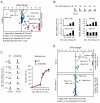Phosphoproteomics reveals distinct modes of Mec1/ATR signaling during DNA replication
- PMID: 25752575
- PMCID: PMC4369404
- DOI: 10.1016/j.molcel.2015.01.043
Phosphoproteomics reveals distinct modes of Mec1/ATR signaling during DNA replication
Erratum in
- Mol Cell. 2015 Apr 2;58(1):194
Abstract
The Mec1/Tel1 kinases (human ATR/ATM) play numerous roles in the DNA replication stress response. Despite the multi-functionality of these kinases, studies of their in vivo action have mostly relied on a few well-established substrates. Here we employed a combined genetic-phosphoproteomic approach to monitor Mec1/Tel1 signaling in a systematic, unbiased, and quantitative manner. Unexpectedly, we find that Mec1 is highly active during normal DNA replication, at levels comparable or higher than Mec1's activation state induced by replication stress. This "replication-correlated" mode of Mec1 action requires the 9-1-1 clamp and the Dna2 lagging-strand factor and is distinguishable from Mec1's action in activating the downstream kinase Rad53. We propose that Mec1/ATR performs key functions during ongoing DNA synthesis that are distinct from their canonical checkpoint role during replication stress.
Copyright © 2015 Elsevier Inc. All rights reserved.
Figures




References
-
- Branzei D, Foiani M. Maintaining genome stability at the replication fork. Nat Rev Mol Cell Biol. 2010;11:208–219. - PubMed
Publication types
MeSH terms
Substances
Grants and funding
LinkOut - more resources
Full Text Sources
Other Literature Sources
Molecular Biology Databases
Research Materials
Miscellaneous

